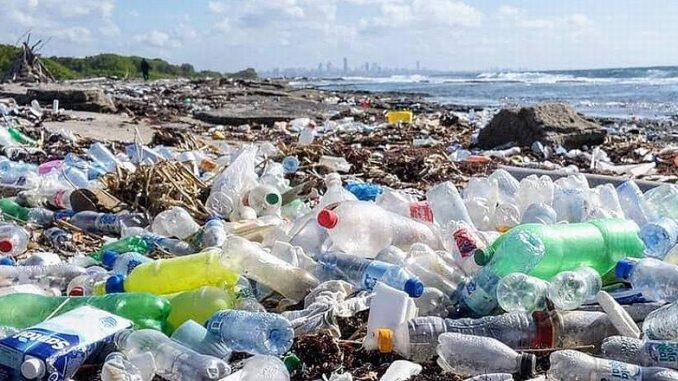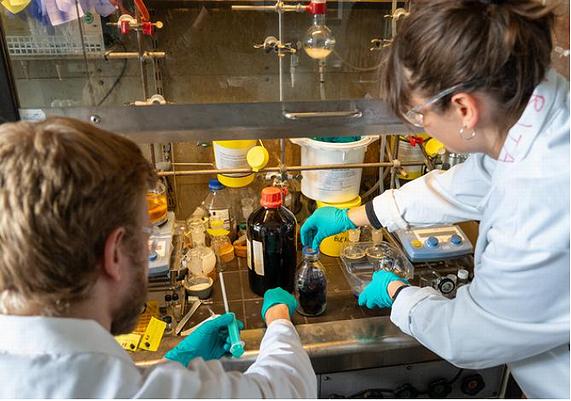
COPENHAGEN, Denmark, September 15, 2025 (ENS) – Scientists at the University of Copenhagen have found a way to convert plastic waste into a climate solution for efficient and sustainable capture of the most abundant greenhouse gas carbon dioxide, CO2 – addressing two major global challenges simultaneously – plastic pollution and the climate crisis.
“The beauty of this method is that we solve a problem without creating a new one,” Margarita Poderyte, a PhD fellow in the Department of Chemistry at the University of Copenhagen and lead author of the research paper, said.
“By turning waste into a raw material that can actively reduce greenhouse gases, we make an environmental issue part of the solution to the climate crisis,” she said.
As CO2 concentrations in the atmosphere keep rising, despite years of political intentions to limit emissions, the world’s oceans are drowning in plastics, which threaten marine environments and ecosystems.
Now a cutting-edge invention from Denmark promises to do two things at once. Researchers at the University of Copenhagen have developed a method where one man’s trash really does become another man’s “treasure,” when decomposed PET plastic becomes the main ingredient in efficient and sustainable CO2 capture.
PET plastic, polyethylene terephthalate, is a strong, transparent, and versatile polyester resin used for packaging food and beverages, as well as in textiles and films. It’s recognizable by the recycling number 1 stamped on items made from it. This is one of the most widely used types of plastic in the world, but when PET has served its purpose as a plastic bottle or textile, it becomes a global environmental issue.
Annual global production of PET reaches 70 million metric tons, accounting for 18 percent of all plastic output. Yet PET waste recycling is limited due to inadequate collection infrastructure, the complexity of sorting, and the lower market demand and economic viability of recycled PET compared to using virgin PET resin, the Danish chemists report.

They estimate that today 85 to 90 percent of produced PET is either incinerated to supply energy or landfilled. Both pose environmental challenges and contribute to additional CO2 emissions. Only 10 to 15 percent of PET is recycled, predominantly through mechanical and chemical methods, yet “the efficacy of these methods needs substantial improvement,” the Copenhagen chemists write in their paper.
It is disposed in landfills in many parts of the world, where it breaks down into polluting microplastics that spread to the air, soil and groundwater or migrate to the oceans.
With the new chemical technology developed in Copenhagen, researchers can transform PET plastic waste into a primary resource as a new form of CO2 sorbent, an insoluable material that can remove an unwanted gas from the air. Existing solid sorbents for carbon capture are porous, solid-phase materials, including mesoporous silicas, zeolites, and metal-organic frameworks.
But while solid adsorbents suitable for carbon capture and storage are an active area of research in materials science, technological and policy obstacles limit the availability of these technologies.
The biggest challenge to this kind of carbon capture from coal-fired power plants, for instance, is the large amount of electricity required. Without policy or tax incentives, the production of electricity from such plants is not competitive with other energy sources as wind and solar power become cheaper and more easily available.
The Copenhagen U. process upcycles PET plastic to a new material the researchers have named BAETA, which can absorb CO2 out of the atmosphere so efficiently that it compares with existing carbon capture technologies, the authors say.
BAETA Is the Key
The BAETA material has a powdery structure that can be pelletized, and a chemically upgraded surface, that enables it to bind and chemically capture CO2.
Once the sorbent is saturated, the captured CO2 can be released through a heating process that allows the CO2 to be concentrated, collected and stored or converted into a sustainable resource.
In practice, the researchers expect the technology to be first installed on industrial plants with exhausts from chimneys passing through BAETA units to cleanse them of CO2.
The research paper entitled “Repurposing Polyethylene Terephthalate Plastic Waste to Capture Carbon Dioxide” is now published in the journal “Science Advances” and describes the chemical process behind the invention. The process is gentle compared to existing technologies and, at the same time, well-suited for industrial scaling.
“The main ingredient is plastic waste that would otherwise have an unsustainable afterlife, and the synthesis we use, where the chemical transformation takes place, is gentler than other materials for CO2 capture because we can make the synthesis in ambient temperatures. It also has the advantage that the technology can be scaled up more easily,” Poderyte said.
Co-author and Associate Professor Jiwoong Lee, also in the Department of Chemistry, agrees with her and highlights the material’s flexibility.

“One of the impressive things about this material is that it stays effective for a long time. And flexible. It works efficiently from normal room temperature up to about 150 degrees Celsius, making it very useful. With this kind of tolerance to high temperatures, the material can be used at the end of industrial plants where the exhausts are typically hot,” Lee explains.
With a revolutionary idea, a proven method and an effective finished product, the researchers feel ready for the next step.
“We see great potential for this material, not just in the lab, but in real-life industrial carbon capture plants. The next big step is scaling up to produce the material in tonnes, and we’re already working to attract investments and make our invention a financially sustainable business venture,” Poderyte says.
The technical challenges do not worry the researchers. Instead, the decisive challenge, they say, is to persuade decision makers to make the necessary investments. If they succeed in that, the invention could ultimately lead to significant changes.
How CO2 Capture Works
Measured in weight, PET plastic constitutes over 60 percent of carbon, and the material has an inherent chemical and physical ability to maintain the structure.
This ability is enhanced by transforming the plastic by adding a quantity of ethylenediamine, a compound known for its ability to bind CO2.
The process breaks down the plastic from polymer to a monomer, giving the material, called BAETA, a chemical composition that is very effective in pulling CO2 out of the air and binding it.
In industrial plants, the idea is to transmit the exhaust through BETA units, which will cleanse it of CO2. When the BAETA material is saturated, its efficiency decreases; however, CO2 can be released from the plastic through a heating process, restoring its efficiency.
The carbon released can then be stored underground or used in Power-to-X, or Power2X plants, as CO2.
P2X conversion technologies allow for the decoupling of power from the electricity sector for use in other sectors such as transport or chemicals. The X in the terminology can refer to: power-to-ammonia, power-to-chemicals, power-to-fuel, power-to-gas (power-to-hydrogen, power-to-methane) power-to-liquid (synthetic fuel), power to food, or power-to-heat.
Large amounts of PET plastic accumulate in the oceans, damaging ecosystems and breaking down into microplastics, the full consequences of which are as yet unknown. But the University of Copenhagen’s new technology turns the plastic waste into power.
“If we can get our hands on the highly decomposed PET plastic floating in the world’s oceans, it will be a valuable resource for us as it’s so well suited for upcycling with our method,” Poderyte said.
This project is supported by the Novo Nordisk Foundation CO2 Research Center in collaboration with the group of Niels Christian Nielsen, Aarhus University.
Featured image: Plastic bottles on the beach at San Gregorio de Nigua, a small city on the southern shore of the Dominican Republic in the Caribbean Sea. (Photo courtesy Birds Caribbean)



